Ice Cream & Health
When Can Babies Have Ice Cream?
Understand when it’s safe to introduce ice cream to your baby and discover essential tips to ensure a delightful experience for both of you.

You can start introducing ice cream to your baby after they turn 12 months old, as their digestive system is better equipped to handle dairy by then. Before this age, it's wise to offer only small tastes to check for allergic reactions. Make sure to choose ice cream made from pasteurized milk and avoid flavors with honey or raw eggs. Always serve in small portions to manage sugar intake, and consider ice cream a special treat rather than a regular snack. If you're curious about safe serving tips and healthier alternatives, there's plenty more to explore.
Key Takeaways
- Ice cream can be introduced to babies after they are 12 months old for better digestion of dairy products.
- Start with small tastes before 12 months to check for potential allergic reactions and monitor for discomfort.
- Always use ice cream made from pasteurized milk and avoid raw ingredients like honey.
- Serve ice cream in 1-2 tablespoon portions occasionally to manage sugar intake and avoid dental issues.
- Consider healthier alternatives like yogurt or frozen fruit purees before introducing ice cream to promote better nutrition.
When to Introduce Ice Cream
Introducing ice cream to your baby can be an exciting milestone, but timing is key. Experts suggest that you can safely introduce ice cream to your little one after they turn 12 months. At this age, their digestive systems are more developed and can handle dairy products better.
Before this point, it's best to offer only small tastes of ice cream to gauge their reaction and check for any signs of allergic reactions. Additionally, it's important to be mindful of your baby's overall diet and guarantee they're getting a balanced intake of nutrients, especially as they shift to solid foods effectively during this period.
When you do start introducing ice cream, make sure it's pasteurized and free from any raw ingredients like honey, which can be dangerous for infants.
Keep an eye on your baby for any signs of discomfort, such as vomiting or skin rashes, after tasting ice cream. This can help guarantee that the treat is indeed ice cream safe for them.
Safety Considerations for Ice Cream

Once you've decided to introduce ice cream to your baby's diet, it's important to take into account safety factors to guarantee a positive experience.
First, make sure your baby is at least 12 months old. This age is significant because their digestive systems are better equipped to handle dairy products. A holistic lifestyle approach can also help support your baby's overall health as they begin to explore new foods.
Always opt for ice creams made from pasteurized milk to minimize the risk of foodborne illnesses.
When introducing ice cream, watch closely for any signs of food allergies. Common allergens like cow's milk, eggs, and nuts are often present in ice cream, so it's crucial to introduce them one at a time.
Stick to ice creams without added sugars or artificial ingredients, as these aren't safe for your baby and can pose health risks.
Lastly, consider choking hazards. Choose ice creams that don't contain hard pieces or toppings, and serve them in small, manageable amounts.
This approach helps make sure that your little one enjoys this treat safely. By paying attention to these safety considerations, you can make ice cream a delightful addition to your baby's diet without unnecessary risks.
Nutritional Value of Ice Cream

While ice cream can be a fun treat for babies, it's important to reflect on its nutritional value. This popular dairy product does provide some benefits, like calcium and vitamin D, which are crucial for bone health. However, it's also packed with sugar and fat. An average serving of vanilla ice cream contains around 21 grams of added sugar—about 1.5 tablespoons—which can be excessive for your baby's small stomach.
Furthermore, many ice creams can contain non-vegan ingredients, which can be concerning for parents who prefer plant-based diets, as vegan alternatives may offer better nutritional options.
Although ice cream can be enjoyed in moderation, its limited nutritional value compared to whole foods makes it less justifiable as a regular part of your child's diet. The high sugar content might lead to dental issues and obesity if consumed too frequently. So, moderation and careful portion control are essential.
You might want to ponder healthier alternatives, like frozen yogurt or homemade ice cream made with controlled ingredients and lower sugar. These options can provide similar textures while offering better nutritional profiles.
Ultimately, while ice cream can be a delightful treat, prioritize your baby's overall nutrition and health by limiting their intake and exploring better choices.
Preparing Ice Cream for Babies

When it comes to preparing ice cream for babies, timing and ingredients are essential. You should wait until your baby is at least 12 months old, as their digestive systems need to be more developed to handle ice cream safely.
Choosing ice cream made from whole milk that's been pasteurized is vital, avoiding any with added sugars or artificial sweeteners, which can be harmful. Additionally, consider using essential oils for relaxation to create a calming environment while enjoying this treat together.
To enhance the flavor and nutritional value, consider adding fresh, safe fruits like strawberries, blueberries, or bananas. Just make sure any fruit pieces are small enough to prevent choking hazards, allowing your baby to enjoy self-feeding safely.
As you introduce ice cream, keep an eye out for any allergic reactions, especially if your baby hasn't previously been exposed to dairy. It's important to be cautious, as dairy can be a common allergen.
Portion Sizes and Frequency

Portion sizes and frequency are essential factors to evaluate when introducing ice cream to your baby's diet. The recommended serving size for ice cream is just 1-2 tablespoons. This helps prevent overconsumption and manage sugar intake effectively.
You want to make sure that ice cream remains an occasional treat rather than a regular snack. Balancing it with nutrient-dense foods is vital for your baby's overall health.
Keep an eye on your baby's overall sugar intake throughout the day, especially if they're under 2 years old. Frequent consumption of ice cream can lead to dental issues and may diminish your baby's interest in healthier foods, making moderation key.
Introduce ice cream slowly and observe your little one for any allergic reactions or digestive discomfort when you first offer it.
Allergen Awareness

Introducing ice cream to your baby's diet means being mindful of allergens that could trigger reactions. Many ice creams contain common allergens like cow's milk, eggs, soy, and tree nuts. Before serving, always read labels carefully to identify potential allergens.
According to pediatric guidelines, it's best to introduce these allergens individually before combining them, ideally by 12 months of age. This way, you can monitor for any allergic reactions.
If your baby shows any symptoms—like vomiting, hives, or swelling—after trying ice cream, it's essential to observe them closely.
Cross-contamination can also happen in ice cream parlors, so when ordering, ask for new containers and clean scoops to minimize the risk.
Choking Hazards to Consider

Considering the potential choking hazards, it's important to serve ice cream in a way that's safe for your baby. Ice cream can pose a low choking risk when you stick to appropriate textures and portion sizes. However, avoid adding hard pieces like candy and nuts, as these can be dangerous for young children.
Ice cream cones, especially the firm ones, should be saved for older kids who've developed the necessary chewing skills. Instead, opt for a bowl and a spoon to minimize risks. Large chunks or hard toppings can obstruct a baby's airway, and since babies often struggle with chewing, this makes supervision even more vital.
Always keep an eye on your little one while they enjoy their ice cream to confirm they're eating safely and to spot any signs of choking.
Health Risks of Ice Cream

While keeping an eye on choking hazards is important, it's equally essential to be aware of the health risks associated with ice cream. Many parents mightn't consider the potential downsides when introducing their little ones to this sweet treat.
Here are a few health risks you should keep in mind:
- Dental issues: Ice cream's high sugar content, averaging around 21 grams per serving, can contribute to cavities in developing teeth.
- Lactose intolerance: Babies who are lactose intolerant may experience gas, bloating, or diarrhea after consuming ice cream.
- Digestive issues: Introducing dairy products too early can lead to upset stomachs or allergic reactions in infants.
- Artificial ingredients: Commercial ice cream often contains preservatives and additives that aren't suitable for young children.
- Obesity risk: Regular consumption of sugary treats like ice cream can lead to unhealthy weight gain in babies.
Being aware of these health risks can help you make informed decisions about when and how to introduce ice cream into your baby's diet.
Always consult your pediatrician for personalized advice.
Alternatives to Ice Cream

If you're looking for healthier options to satisfy your baby's sweet tooth, there are plenty of delicious alternatives to ice cream. One great choice is yogurt, which is usually lower in sugar and packed with probiotics that aid digestion. You can easily find yogurt options specifically designed for babies.
Frozen fruit purees are another excellent alternative. Just blend fruits like bananas or strawberries to create a naturally sweet and nutritious treat. These purees can also be frozen for a revitalizing snack.
If you want to get creative, consider making banana nice cream by blending frozen bananas. This dairy-free option is creamy, satisfying, and free from added sugars.
Additionally, homemade smoothies can introduce a variety of fruits and vegetables. You can freeze these smoothies for a nutrient-dense, icy delight that your baby will love.
Finally, sorbet made from pureed fruit offers a revitalizing way to cool down without the high sugar and fat content found in traditional ice cream.
These alternatives to ice cream not only satisfy cravings but also provide essential nutrients for your little one. Enjoy experimenting with these tasty treats!
Expert Recommendations on Ice Cream

Most pediatricians recommend introducing ice cream to your baby only after they turn one year old, when their digestive systems are more developed. It’s important to also consider any potential allergies or sensitivities your baby may have to dairy products. It’s best to introduce small amounts of ice cream and monitor for any adverse reactions. Additionally, it’s crucial for pregnant women to be mindful of their ice cream consumption during pregnancy due to the potential for excessive weight gain and related health concerns.
At this age, you can start offering small amounts of ice cream, but be cautious. Here are some expert recommendations to keep in mind:
- Verify the ice cream is pasteurized and free from honey or raw eggs.
- Start with small portions to monitor for allergies, especially to cow's milk.
- Treat ice cream as an occasional treat, not a staple in their diet.
- Be mindful of sugar and fat content, as these can lead to dental issues.
- Gradually introduce ice cream to help establish healthy eating habits.
Frequently Asked Questions
Can My 6 Month Old Have Ice Cream?
You shouldn't give your 6-month-old ice cream yet. Their digestive system isn't ready for dairy or high sugar. Focus on nutrient-rich foods now to support their growth before introducing treats later.
When Can Babies Have Dairy?
When you think about introducing dairy, remember that around 6 months is a good time for yogurt and cheese. Just be cautious; always watch for allergies and consult your pediatrician to guarantee it's safe.
Will My Baby Get Cold if I Eat Ice Cream While Breastfeeding?
No, your baby won't get cold if you eat ice cream while breastfeeding. Your body regulates temperature well, so enjoy the treat in moderation, but be mindful of any allergens that might affect your baby.
What Can Babies Eat at 6 Months?
At six months, you'll find your baby's palate ready for adventure. Introduce iron-fortified cereals, pureed fruits, veggies, and small amounts of meats, one at a time, to guarantee they adjust and thrive.
Conclusion
In summary, introducing ice cream to your baby can be a fun treat, but timing and safety matter. Did you know that around 15% of children under two have dairy allergies? That's why it's essential to monitor your baby's reactions. When you do decide to share a scoop, opt for healthier alternatives and keep portions small. Ice cream can be an occasional delight, but balance is key to guarantee your little one stays healthy and happy.
Giulia is the creative force behind our content strategy. With a knack for storytelling and a deep understanding of what our readers want, she plans and develops the content that keeps “Icecream Hater” fresh and exciting. Giulia works closely with the editorial team to ensure that every article, recipe, and review aligns with our mission and vision. She aims to inspire our readers to explore, create, and enjoy ice cream in new and innovative ways.
Ice Cream & Health
Dairy-Free Options at Cold Stone Creamery?
Indulge in sweet delights at Cold Stone Creamery. Find out if they offer dairy-free ice cream and explore plant-based dessert options today!
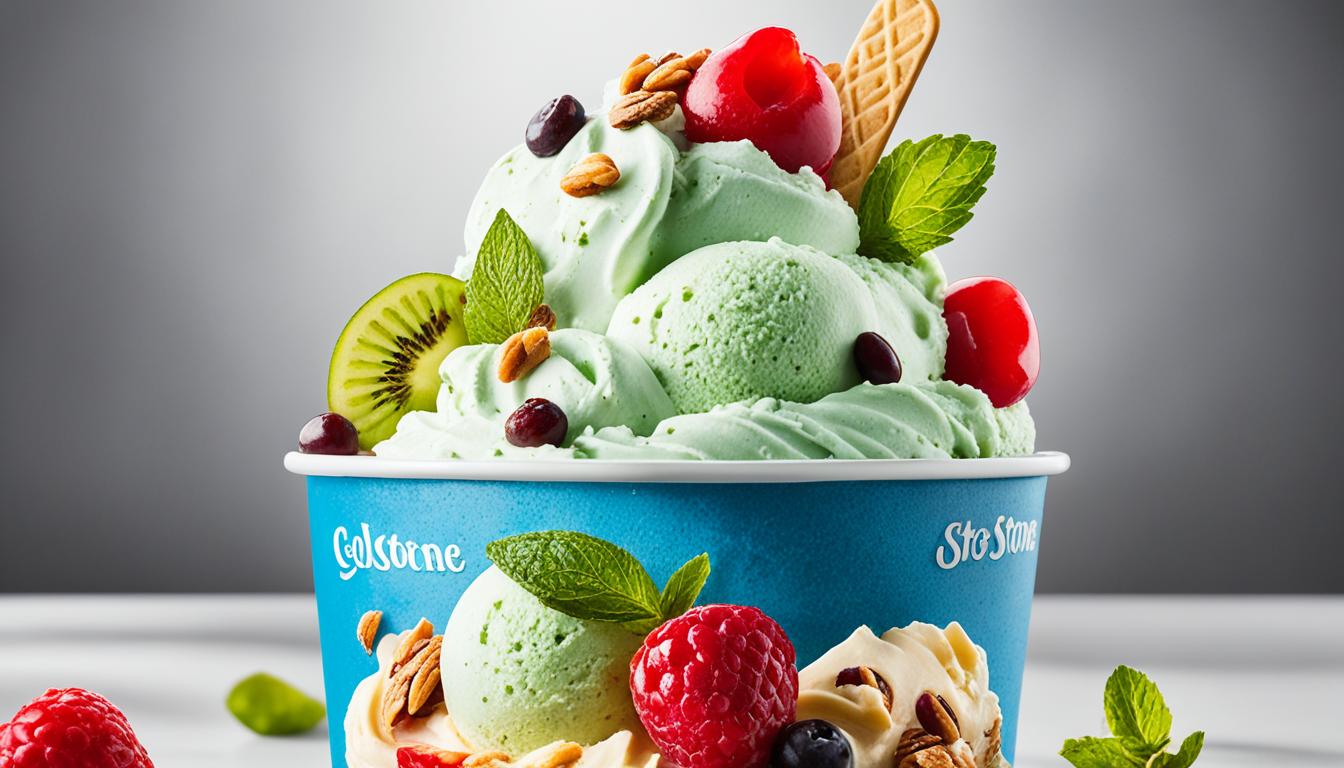
There’s something truly nostalgic about indulging in ice cream on a hot summer day—a simple scoop that can bring back memories of laughter and sweetness. But for many, enjoying this classic treat has become a challenge due to dietary restrictions. You may find yourself wondering, does Cold Stone have dairy free ice cream? Fortunately, Cold Stone Creamery is stepping up to the plate with a variety of dairy-free options that don’t skimp on flavor. After partnering with Danone, they now offer the Silk Chocolate Almondmilk Frozen Dessert, leading the charge in accessible and enjoyable treats for everyone.
Whether you’re searching for a delightful dessert that aligns with your plant-based lifestyle or simply craving something cool and refreshing, Cold Stone dairy free options are designed to satisfy. From rich almond milk creations to zesty sorbets, the possibilities are just a scoop away. Join us as we explore how Cold Stone is reimagining ice cream for all taste buds and dietary needs, making it easier for you to treat yourself—guilt-free!
Key Takeaways
- Cold Stone has partnered with Danone for their first dairy-free flavor: Silk Chocolate Almondmilk Frozen Dessert.
- Many locations offer a rotating selection of dairy-free ice cream flavors and sorbets.
- Dairy-free mix-ins and toppings enhance customization for your unique dessert experience.
- Vegan-friendly options are available, including creative concoctions like Don’t Cry Over Spilled Silk.
- Cake cones and sugar cones are available as dairy-free alternatives to traditional waffle cones.
Understanding Dairy-Free Ice Cream Choices
Dairy-free ice cream choices have gained immense popularity in recent years. Many consumers are embracing dairy alternatives at Cold Stone to meet their dietary needs and preferences. Understanding the available options can enhance your cold dessert experience, especially if you’re looking for delicious treats without dairy. Cold Stone offers a variety of non-dairy options, with choices ranging from almond milk-based to coconut milk-based ice creams. These alternatives provide a creamy texture and rich flavor while catering to those with lactose intolerance or vegan preferences. With ice cream ingredients explained on their menu, customers can make informed decisions about what suits their dietary needs without compromising on taste.

Exploring Plant-Based Alternatives
Cold Stone Creamery has stepped up its game by introducing an impressive selection of vegan options. Among these, you can find the Chocolate Silk Shake, as well as the “Don’t Cry Over Spilled Milk” and “Very Berry Non-Dairy” ice cream creations. All these options use Silk Chocolate Almondmilk Frozen Dessert as a creamy base, ensuring a rich and delightful texture.
Customization is another highlight of the dairy free ice cream cold stone experience. You have the opportunity to select a variety of vegan mix-ins including fresh fruits, nuts, and Oreos. This allows for a personalized touch to each treat, making your dessert both fun and satisfying.
As the market for plant-based ice creams continues to grow, Cold Stone remains committed to evolving its menu. The introduction of vegan-friendly sugar cones and an array of vegan mix-ins showcases the brand’s willingness to adapt to customer preferences. Understanding these offerings can ensure you enjoy a genuinely delicious and inclusive dairy-free ice cream experience.
Does Cold Stone Have Dairy Free Ice Cream?
Cold Stone Creamery has made strides to cater to those seeking dairy-free options, showcasing a commitment to a variety of dietary preferences. You’ll be pleased to know that this beloved brand offers a unique dairy-free ice cream, specifically the Silk Chocolate Almondmilk Frozen Dessert. This dessert is crafted from almond milk and organic coconut oil, fitting perfectly within both vegan and lactose-free diets.
Overview of Silk Chocolate Almondmilk Frozen Dessert
The Silk Chocolate Almondmilk Frozen Dessert offers a rich, creamy texture without sacrificing taste. With its delicious chocolate flavor, this frozen treat not only satisfies cravings but also aligns with the needs of many health-conscious consumers. It holds the distinction of being both vegan ice cream cold stone and lactose free ice cream cold stone compatible.
Vegan and Lactose-Free Options
While Cold Stone Creamery has various plant-based offerings, it’s essential to be aware of some limitations. Although their smoothies aren’t vegan due to the Lifestyle Smoothie mix containing milk, you can enjoy their vibrant sorbet selections. Flavors like Lemon, Mojito, and Strawberry offer delectable, dairy-free enjoyment. Moreover, the mixing slate is carefully cleaned between customers to minimize the risk of cross-contamination, allowing for a worry-free experience when selecting your dairy-free treat.
You can find a wealth of vegan choices when customizing your frozen creation. Mix-ins such as OREO Cookies, fresh fruits, and various types of nuts add texture and flavor while maintaining the vegan integrity of your dessert. Cold Stone’s selection truly commits to providing tasty vegan options for every palate.

| Feature | Details |
|---|---|
| Vegan Ice Cream | Silk Chocolate Almondmilk Frozen Dessert |
| Lactose-Free Options | Silk Chocolate Almondmilk Frozen Dessert |
| Dairy-Free Sorbets | Lemon, Mojito, Strawberry, Peach Mango |
| Mix-In Options | OREO Cookies, Fresh Fruit, Nuts |
| Non-Vegan Mix-Ins | Gummy Bears, Marshmallows |
Dairy-Free Frozen Dessert Flavors
When craving a refreshing treat, Cold Stone Creamery presents you with delightful dairy-free options tailored to suit your palate. A spotlight shines on the Silk Chocolate Almondmilk Frozen Dessert, which boasts a creamy texture derived from almond ingredients. This new dessert reflects the growing demand for plant-based indulgence, allowing you to savor your sweet tooth without concerns regarding dairy.
Silk Chocolate Almondmilk Details
This indulgent frozen dessert encapsulates the rich, chocolaty flavor that chocolate lovers seek while being completely dairy-free. The combination of Silk almond milk and unique add-ins provides an avenue for creativity and personalization at Cold Stone. You can enjoy flavors like the fan-favorite Don’t Cry Over Spilled Silk, which combines Silk vegan ice cream with slices of banana, a spread of peanut butter, and crunchy roasted almonds. This treat is not only delicious but also packed with nutrients, making it a worthy addition to the Cold Stone dairy free options.
Sorbet Varieties Offered
In addition to the almond milk dessert, Cold Stone features a selection of vibrant sorbet flavors that are naturally dairy-free and lactose-free. Each fruity variety is crafted to provide a burst of flavor while ensuring a smooth, pleasing mouthfeel. Here are some of the lively sorbet flavors you can find:
- Lemon
- Strawberry
- Peach Mango
Availability of these sorbet flavors may differ by location and season, encouraging you to check your nearest store for the freshest options. With an array of dairy free ice cream Cold Stone offers, there is something for everyone to enjoy.

| Flavor Type | Flavor Name | Base Ingredients |
|---|---|---|
| Frozen Dessert | Silk Chocolate Almondmilk | Almond Milk, Cocoa |
| Sorbet | Lemon | Water, Lemon Juice |
| Sorbet | Strawberry | Water, Strawberry Puree |
| Sorbet | Peach Mango | Water, Peach Puree, Mango Puree |
With these enticing choices, indulging in dairy-free goodness has never been more enjoyable at Cold Stone Creamery.
Mix-Ins & Customization for Dairy-Free Treats
At Cold Stone Creamery, creating your own dessert allows for endless possibilities. A variety of cold stone dairy free options lets you satisfy your cravings while sticking to a dairy-free diet. You might be wondering, does Cold Stone have dairy free ice cream? The answer is a resounding yes, with the introduction of the Silk Chocolate Almondmilk Frozen Dessert.
Popular Dairy-Free Mix-Ins
Customize your dairy-free treat with an exciting selection of mix-ins. Here are some popular options:
- Bananas
- Strawberries
- Roasted Almonds
- Golden Oreo Cookies
- Graham Cracker Pie Crust
- Rainbow Sprinkles
How to Create Your Own Dairy-Free Creation
You have the freedom to explore various combinations to craft a unique dairy-free experience. Consider ordering the special “Don’t Cry Over Spilled Silk,” which features the Silk Chocolate Almondmilk Frozen Dessert blended with your choice of dairy-free mix-ins. Pair it with toppings like Cinnamon or Reese’s Peanut Butter Sauce for an extra burst of flavor. The range of available dairy-free mix-ins and toppings means that your custom creation can be tailored to your preferences, ensuring a delightful treat every time.
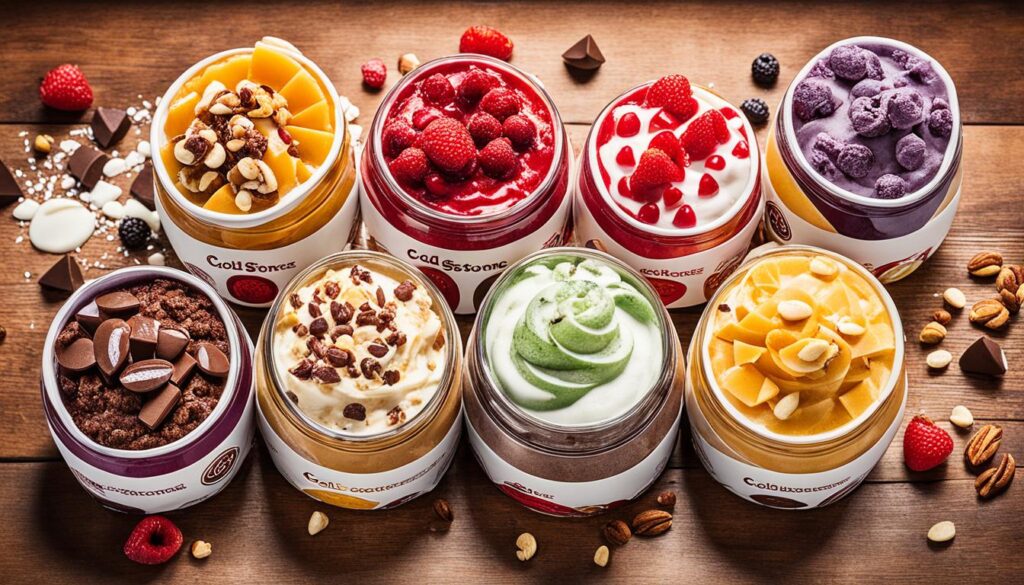
Cross-Contamination Risks
When enjoying vegan ice cream cold stone, it’s crucial to be aware of cross-contamination risks that may arise, especially for customers with allergies. Cold Stone Creamery prioritizes customer safety by encouraging patrons to communicate any allergies or dietary restrictions to the staff. The team is well-trained to handle these requests and can take appropriate measures to minimize risks.
Importance of Informing Staff About Allergies
Informing the staff about your allergies allows them to take necessary precautions during the preparation of your order. This step is particularly important when exploring dairy alternatives at cold stone, where various mix-ins and toppings can come into contact with dairy products. Open communication ensures that clean utensils and dedicated mixing areas are used, which helps to provide a safer experience for everyone.
Precautions Taken by Cold Stone Creamery
Cold Stone Creamery takes several precautions to mitigate cross-contamination risks. Staff members wash their hands with soap and hot water as per health regulations and always wear fresh, single-use gloves for each service. They are trained in food safety, ensuring that steps are taken to avoid contact between dairy products and dairy alternatives at cold stone.

Reviewers have noted the effectiveness of these measures, with positive feedback often highlighting the staff’s willingness to accommodate dietary needs. Each Cold Stone location aims for a celiac-friendly approach, enhancing customer confidence during their visit.
| Safety Measure | Description |
|---|---|
| Staff Training | Employees are trained in food safety to provide allergy-safe service. |
| Hand Washing | Employees wash hands with soap and hot water according to health regulations. |
| Single-Use Gloves | New gloves are used for each service to prevent cross-contact. |
| Communication | Customers are encouraged to inform staff about allergies for tailored service. |
| Dedicated Mixing Areas | Staff can use separate utensils and mixing areas for allergy-friendly orders. |
Plant-Based Ice Cream Options at Cold Stone
Cold Stone Creamery has made strides in offering exciting options for those seeking dairy-free delights. With the introduction of the Silk Chocolate Almondmilk Frozen Dessert in January 2022, customers can enjoy a genuinely creamy and flavorful vegan ice cream alternative. This addition establishes Cold Stone as a contender in the plant-based ice cream cold stone category.
Introduction of Silk Chocolate Almondmilk
The Silk Chocolate Almondmilk Frozen Dessert serves as the first-ever vegan ice cream option at Cold Stone. This dessert is not just a standalone treat but also forms the base for various exciting creations. For example, the “Don’t Cry Over Spilled Silk” Cold Stone Creation combines Silk Chocolate Almondmilk Frozen Dessert with banana, peanut butter, and roasted almonds, creating a deliciously rich experience. Additionally, customers can indulge in the Chocolate Silk Shake, which blends this delightful almondmilk frozen dessert with Silk Almondmilk.
Potential for Cross-Contamination
While cold stone has dairy free ice cream options, it is crucial for customers to be aware of the potential for cross-contamination. Cold Stone Creamery takes precautions, but shared equipment and utensils may pose a risk for those with severe allergies. Be sure to discuss your specific dietary needs with the staff to ensure a safe and enjoyable experience. Cold Stone Creamery offers a range of vegan toppings, including cinnamon and Reese’s Peanut Butter Sauce, enhancing the customizability of your dairy-free treats. You can also choose from two vegan cone options, including Cake Cone and Sugar Cone, elevating your dessert experience.

| Vegan Options | Description |
|---|---|
| Silk Chocolate Almondmilk Frozen Dessert | A rich, creamy base for various vegan treats. |
| Don’t Cry Over Spilled Silk | Silk Chocolate Almondmilk with banana, peanut butter, and roasted almonds. |
| Chocolate Silk Shake | A delicious shake made with Silk Chocolate Almondmilk Frozen Dessert and Silk Almondmilk. |
| Countrytime Pink Lemonade Sorbet | A refreshing vegan sorbet option. |
| Vegan Mix-Ins | Oreo Cookies, Peanut Butter, Rainbow Sprinkles, and more. |
By offering thoughtful plant-based options, Cold Stone Creamery is responding to the growing demand for dairy-free desserts. You can enjoy a delightful experience while adhering to your dietary preferences, knowing you’re not alone in the quest for tasty, inclusive treats.
Dairy Alternatives at Cold Stone
When visiting Cold Stone Creamery, you will find a delightful assortment of non-dairy choices designed to satisfy your cravings while accommodating dietary preferences. Beyond the Silk Chocolate Almondmilk Frozen Dessert, a range of refreshing sorbet flavors awaits you, each crafted to provide a sweet escape for those avoiding dairy.
Exploration of Non-Dairy Choices
At Cold Stone, the commitment to offering dairy free ice cream cold stone options shines through. Choices like Lemon Sorbet, Peach Mango Sorbet, and Raspberry Sorbet cater to your taste buds while remaining completely dairy-free. Flavor availability may vary by promotion and location, so keep an eye out for seasonal specialties. With approximately 1,500 locations across over 28 countries, there is a good chance you can find a Cold Stone nearby featuring these unique offerings.
Highlighting Unique Offerings
Among the standout cold stone dairy free options is the “Don’t Cry Over Spilled Silk” creation, which combines Silk Chocolate Almondmilk Frozen Dessert with banana, peanut butter, and roasted almonds for a delicious treat. Additionally, mix-ins like bananas, blueberries, and coconut enhance your dairy-free experience. Cold Stone ensures transparency in all their offerings, particularly with cones; you can choose between Cake and Sugar Cones, both free from dairy, soy, and wheat. Don’t forget that all their sorbets are vegan-friendly, providing an inclusive dessert experience for everyone.
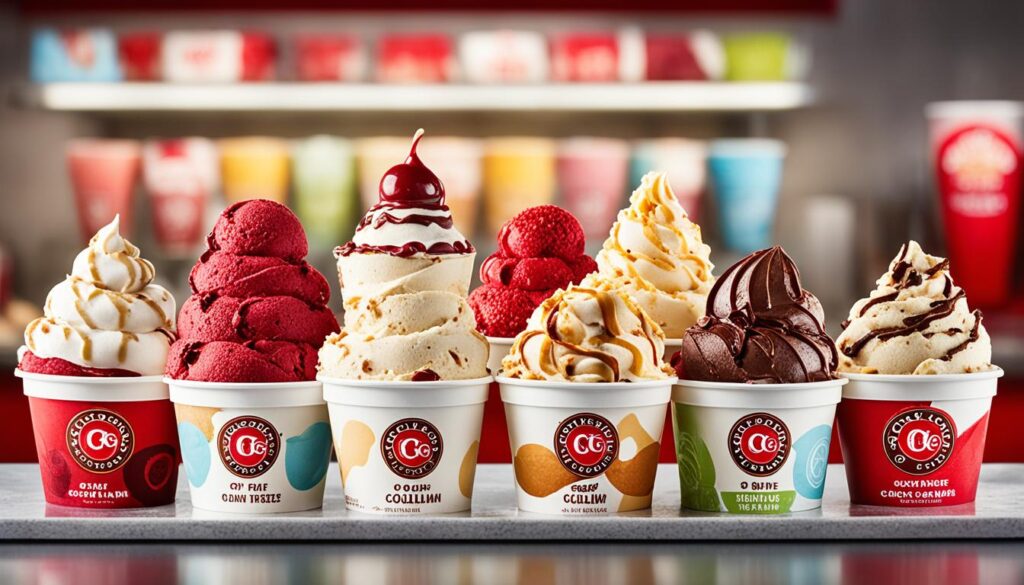
Nutritional Information for Dairy-Free Options
When it comes to enjoying sweet treats, knowing what’s in your food can help make informed choices. Cold Stone Creamery stands out with its commitment to providing nutritional information for its dairy-free offerings. Whether you’re seeking a lactose free ice cream cold stone experience or exploring other dairy alternatives at cold stone, understanding these options will guide your selections.
Ingredient Transparency
Transparency about ingredients is crucial for health-conscious consumers. The Chocolate Silk® Almondmilk Frozen Dessert, one of the premier dairy-free ice cream choices, features almond milk, organic coconut oil, and cane sugar as primary components. This delectable alternative fits perfectly within a plant-based diet. Sorbet selections like Lemon, Mojito, and Pineapple are also available, all lactose-free and low in calories, making them a great option for anyone monitoring their intake.
Health-Conscious Choices Available
Cold Stone Creamery offers a range of portion sizes, including Like It® (approximately 5 oz), Love It® (approximately 8 oz), and Gotta Have It® (approximately 12 oz). The calorie content varies widely among different dairy-free items, giving you the flexibility to choose what fits your dietary goals. Here’s a comparison of some popular options:
| Treat | Portion Size | Calories |
|---|---|---|
| Chocolate Silk® Almondmilk Frozen Dessert | Like It® | 150 |
| Vanilla Lite Ice Cream | Like It® | 100 |
| Sorbet (various flavors) | Like It® | 90-120 |
With these nutritious selections, indulging in a lactose free ice cream cold stone experience can be both pleasurable and aligned with your health goals. The diverse options at Cold Stone ensure there’s something for everyone, appealing to those who prioritize dietary needs without sacrificing flavor.

Where to Find Cold Stone Creamery Locations
With over 900 locations across the United States, discovering your nearest Cold Stone Creamery is a breeze. Whether you’re craving their dairy-free options or simply looking to indulge in a rich dessert, locating a shop has never been easier. Before heading out, it’s a wise choice to check what specific dairy free ice cream options they offer to ensure they have what you’re looking for.
Accessing Your Nearest Cold Stone Creamery
To find the location closest to you, visit Cold Stone’s official website and utilize their store locator feature. This tool not only shows you nearby shops but also provides insight into the menu offerings at each site, allowing you to enjoy customized desserts tailored to your dietary needs. Be sure to explore available flavors, including the Silk Chocolate Almondmilk Frozen Dessert, which caters to those seeking vegan and lactose-free delights.
Remember, while Cold Stone’s menu is extensive, the availability of certain flavors and dairy-free options can vary by location. So don’t hesitate to call ahead or check online to confirm that your preferred treat is ready for you when you arrive.
FAQ
Does Cold Stone offer dairy-free ice cream options?
What are the dairy-free ice cream options available at Cold Stone?
Is the Silk Chocolate Almondmilk Frozen Dessert vegan?
Can I customize my dairy-free dessert at Cold Stone?
What are the risks of cross-contamination at Cold Stone?
Are there non-dairy choices suitable for vegans?
How can I find nutritional information for dairy-free options at Cold Stone?
Where can I find a Cold Stone Creamery location near me?
Mia is the connector for the “Ice Cream Hater” team, responsible for spreading the word about our brand and building relationships with our audience and partners. With a background in marketing and a passion for community engagement, Mia manages our outreach efforts, coordinates marketing campaigns, and develops strategies to expand our reach. She is passionate about bringing the joy of ice cream to as many people as possible and is always looking for new ways to share our content with the world.
Ice Cream & Health
Does Ice Cream Help Heartburn?
Wondering if ice cream soothes heartburn? Discover the surprising truth behind this tempting treat and its effects on your symptoms.

Ice cream might seem like a comforting choice for heartburn because its cold temperature can numb the burning sensation. However, its high-fat and sugar content can relax the lower esophageal sphincter and stimulate stomach acid production, worsening your symptoms. While you may experience temporary relief or distraction from the pain, it's not a long-term solution. Many heartburn sufferers find that high-fat foods trigger their symptoms. If you're curious about better options and strategies for managing heartburn, there's plenty more to contemplate that might help you feel better.
Key Takeaways
- Ice cream may provide temporary relief from heartburn due to its cold temperature numbing the burning sensation in the esophagus.
- The creamy texture of ice cream can create a protective coating, offering brief respite from heartburn symptoms.
- High-fat and sugar content in ice cream can worsen heartburn by relaxing the lower esophageal sphincter and increasing stomach acid production.
- Ice cream can mimic lactose intolerance symptoms, causing gas and bloating that may complicate heartburn management.
- Alternatives like frozen yogurt or banana ice cream may be better options for those prone to heartburn.
Understanding Heartburn
When you experience heartburn, it often feels like a fiery discomfort in your chest. This sensation is usually caused by acid reflux, where stomach acid flows back into the esophagus due to a malfunctioning lower esophageal sphincter (LES).
As you navigate through your day, you might notice that certain foods trigger this unpleasant feeling. Spicy items, high-fat foods, and even acidic beverages can send your heartburn into overdrive. Maintaining a healthy lifestyle can greatly reduce the likelihood of experiencing such symptoms.
You're not alone—about 20% of the population suffers from gastroesophageal reflux disease (GERD), which involves frequent heartburn episodes. Symptoms can include chest pain, regurgitation, and difficulty swallowing, so it's essential to monitor these signs carefully. You wouldn't want to confuse heartburn with a heart attack.
Lifestyle factors, such as obesity and smoking, can also contribute to your discomfort. To manage your heartburn effectively, consider keeping a food diary. This way, you can identify which foods, including dairy products like ice, may worsen your symptoms.
Ice Cream's Composition

Ice cream's composition plays a significant role in how it affects heartburn. Primarily made from high-fat dairy, it can relax the lower esophageal sphincter (LES), which might worsen acid reflux symptoms for some people.
While you might enjoy a scoop for its creamy texture, that same texture can create a protective coating on the esophagus lining, offering short-term comfort. However, this is a temporary solution. Many dairy products, including ice cream, can be problematic for those who are sensitive to lactose, which is an important consideration for individuals seeking alternatives vegan alternatives and cooking.
The sugar content in ice cream can stimulate your stomach to produce more acid, potentially leading to increased heartburn. And if you're reaching for a larger portion, the high-fat content is generally considered a trigger for acid reflux, making it a risky choice for those prone to heartburn.
Interestingly, the cold temperature of ice cream can numb the esophagus, providing brief relief from the burning sensation. Yet, this relief is short-lived and may not outweigh the risks associated with its high-fat content.
Temporary Relief Mechanism

When you eat ice cream, its cold temperature might numb the burning sensation in your esophagus, offering a brief moment of relief.
The creamy texture can also create a protective coating, making those heartburn episodes feel less intense for a while.
Additionally, certain essential oils, like peppermint, are known for their soothing properties and may help in alleviating discomfort essential oils for sinus congestion relief.
Plus, indulging in a scoop can serve as a distraction from the discomfort, giving you a temporary escape.
Cold Numbing Effect
Relief from heartburn can often feel elusive, but the cold numbing effect of ice cream offers a brief respite. When you indulge in that creamy treat, the cold temperature can temporarily numb your esophagus, potentially easing the immediate burning sensation.
Here's how it works:
- Cooling Sensation: The coldness may numb the throat and esophagus, providing immediate, albeit temporary relief.
- Soothing Effect: Ice cream can create a soothing feeling in your throat, distracting you from discomfort caused by acid reflux.
- Distraction from Discomfort: While enjoying ice cream, you might find your focus shifts away from the burning sensation.
- Variable Relief: Keep in mind that individual reactions to ice cream can differ, so it's vital to monitor your response.
However, remember that this cold numbing effect isn't a long-term solution. It doesn't tackle the underlying causes of heartburn, like the relaxation of the lower esophageal sphincter (LES).
While ice cream may provide temporary relief, it's important to evaluate other methods for managing your heartburn symptoms effectively.
Creamy Coating Benefit
With its creamy texture and soothing coolness, ice cream can create a temporary protective coating on your esophagus lining, which might help alleviate irritation caused by heartburn.
This creamy coating can offer you some immediate relief by soothing the burning sensation that often accompanies heartburn episodes. The coldness of ice cream might further numb your esophagus, enhancing the comfort you feel during these times.
Additionally, dairy products like ice cream can help neutralize stomach acids, giving you a brief respite from the discomfort.
However, it's crucial to take into account the high-fat content of ice cream. While the creamy coating provides temporary relief, the fat can relax the lower esophageal sphincter (LES).
This relaxation might allow stomach acids to rise more easily, potentially worsening heartburn symptoms in the long run.
Temporary Distraction Strategy
Eating ice cream can serve as a temporary distraction from the discomfort of heartburn. Its cold texture and creamy consistency can provide immediate soothing effects, numbing the burning sensation you might feel. For many, the act of indulging in ice cream shifts focus away from pain, making it a popular temporary distraction strategy.
However, keep in mind that this relief is often short-lived.
Here are a few points to contemplate if you're thinking about using ice cream for heartburn:
- Immediate Relief: The coldness can numb your esophagus, offering quick comfort.
- Creamy Coating: The texture may protect your esophagus lining, providing temporary relief.
- Mood Booster: Enjoying ice cream can elevate your spirits, distracting you from discomfort.
- Caution on High-Fat Content: Be aware that high-fat and sugary ice cream can worsen heartburn for some individuals.
While ice cream might help momentarily, remember it's not a long-term solution for managing heartburn. You should listen to your body and reflect on other remedies for persistent symptoms.
Potential Risks of Ice Cream

While ice cream might seem like a soothing treat, its high-fat content can actually relax the lower esophageal sphincter, allowing more stomach acid to escape and worsen heartburn.
Plus, the sugar in ice cream can increase stomach acid production, compounding your discomfort.
If you're lactose intolerant, indulging in ice cream could lead to gas and bloating, creating even more pressure and potential heartburn.
High-Fat Content Impact
Many heartburn sufferers may not realize that ice cream's high-fat content can greatly impact their symptoms. High-fat foods, like ice cream, can relax the lower esophageal sphincter (LES). This relaxation may lead to more stomach acid escaping into the esophagus, worsening acid reflux symptoms.
Here are some potential risks associated with indulging in ice cream:
- Increased Acid Exposure: High-fat dairy delays gastric emptying, prolonging acid exposure in your stomach.
- Trigger for Heartburn: Research shows that 92% of heartburn sufferers identify high-fat items as primary triggers for their symptoms.
- Lactose Intolerance: If you're lactose intolerant, ice cream may cause gas and bloating, adding pressure to the LES.
- Stomach Acid Production: The sugar in ice cream might stimulate increased production of stomach acid, compounding your discomfort.
Being mindful of these factors can help you make informed choices about your diet and manage your heartburn more effectively.
If you notice that ice cream triggers your symptoms, it might be best to limit or avoid this treat.
Sugar Production Increase
Ice cream's sugary allure can be deceptive, especially for those prone to heartburn. The high sugar content in ice cream can stimulate your stomach to produce more acid, which may worsen your heartburn symptoms. When you indulge in this sweet treat, the added sugar can lead to increased gastric acidity, resulting in more frequent acid reflux episodes.
Here's a quick breakdown of how sugar affects heartburn:
| Aspect | Effect | Potential Outcome |
|---|---|---|
| Sugar Consumption | Increases stomach acid production | Heightened heartburn symptoms |
| Gastric Acidity | Contributes to acid reflux | More frequent reflux episodes |
| Blood Sugar Spikes | Provokes digestive discomfort | Exacerbated heartburn |
| Obesity Risk | Linked to high-sugar diets | Increased GERD risk |
Regularly consuming high-sugar foods like ice cream can also lead to obesity, a significant risk factor for developing gastroesophageal reflux disease (GERD) and worsening heartburn symptoms. Being mindful of your sugar intake is vital if you want to keep heartburn at bay.
Lactose Intolerance Effects
For those with lactose intolerance, indulging in ice cream can lead to a range of uncomfortable symptoms that may worsen heartburn. Approximately 65% of the world's population struggles with lactose intolerance, and the combination of dairy and high-fat content in ice cream can complicate things.
Here are some potential risks:
- Gas and Bloating: Consuming ice cream can cause gas and bloating, mimicking heartburn symptoms.
- Diarrhea: Lactose intolerance can lead to diarrhea, further irritating your digestive system.
- LES Relaxation: The high-fat content in ice cream may relax the lower esophageal sphincter (LES), allowing stomach acid to flow back into your esophagus.
- Symptom Confusion: Symptoms from lactose intolerance can overlap with heartburn, making it difficult to manage both conditions effectively.
If you're lactose intolerant, consider lactose-free alternatives to ice cream. These options can provide a similar texture and taste without the digestive discomfort.
Individual Reactions to Ice Cream

While enjoying a scoop of ice cream may bring momentary pleasure, individual reactions can differ widely. For some, the cold texture might provide temporary relief from heartburn symptoms. However, for others, the high-fat and high-sugar content can worsen their discomfort, especially if they deal with lactose intolerance or a sensitive lower esophageal sphincter (LES). Additionally, eating ice cream after tooth extraction is often recommended as a soothing treat due to its cold temperature, which can help reduce swelling and discomfort. However, the sugar content might pose risks if proper oral hygiene isn’t maintained, potentially hindering the healing process. As with any indulgence, it’s essential to consider individual health conditions and consult with a healthcare professional if necessary.
| Individual Reaction | Heartburn Symptoms | LES Impact |
|---|---|---|
| Relief | Mild discomfort | No change |
| Discomfort | Increased burning | Relaxation |
| Bloating | Gas | Pressure |
| Nausea | Strong pain | Weakness |
| No effect | None | Stable |
Since approximately 92% of those suffering from heartburn identify food as a trigger, it's essential for you to monitor your own experiences. Keeping a food diary can help you track your individual reactions to ice cream, allowing you to adjust your diet accordingly. Remember, what works for one person might not work for you!
Alternatives to Ice Cream
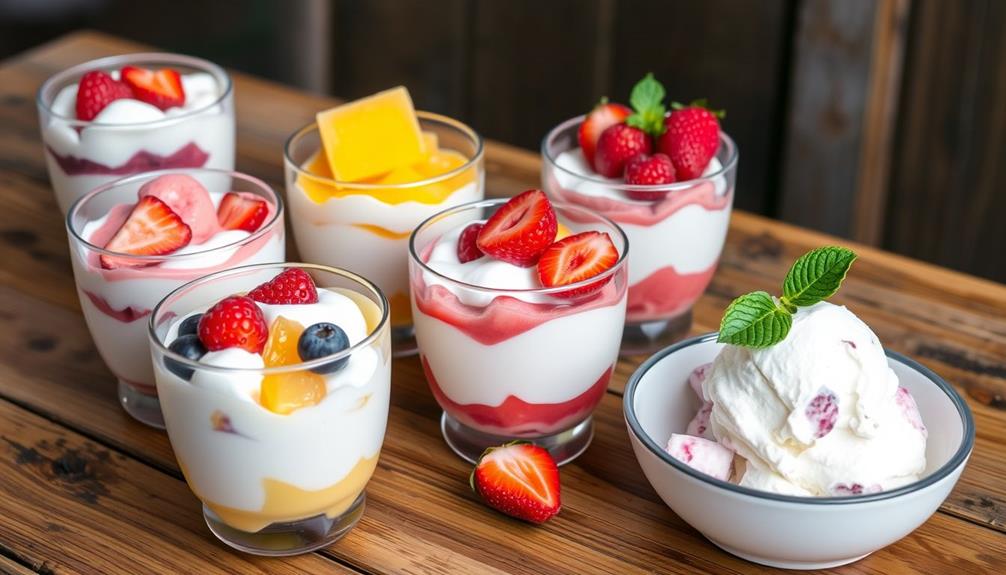
If you're seeking alternatives that can satisfy your sweet tooth without aggravating heartburn, there are several delicious options to contemplate. You don't have to sacrifice flavor for comfort. Here are some great choices:
- Frozen Yogurt: Opt for low-fat varieties, which provide a creamy texture with less fat than ice cream, potentially reducing the risk of heartburn symptoms.
- Fruit Sorbet: Made primarily from fruit and water, sorbet is typically lower in fat and dairy-free, making it a revitalizing choice that avoids lactose.
- Banana Ice Cream: Blend frozen bananas for a creamy, naturally sweet treat that's easier on your digestive health compared to traditional ice cream.
- Coconut Milk Ice Cream: This dairy-free option made from coconut milk offers a rich texture while being lower in lactose, ideal for those sensitive to dairy.
Additionally, consider chia seed pudding, made by soaking chia seeds in almond or coconut milk. It's high in fiber, promotes digestive health, and won't trigger heartburn.
These alternatives can help satisfy your cravings while keeping discomfort at bay!
Dietary Recommendations for Heartburn
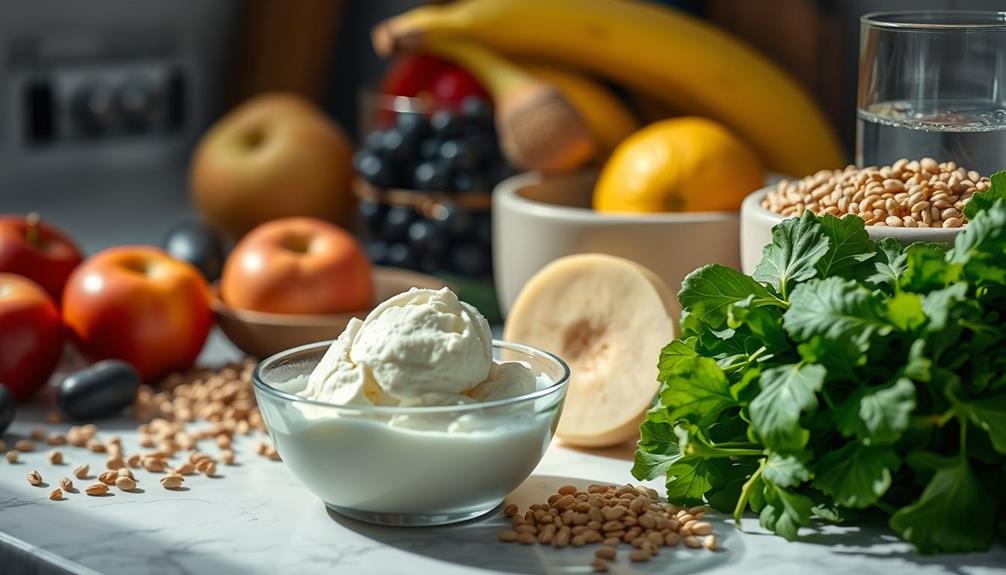
Managing heartburn requires thoughtful dietary choices that can ease discomfort and promote better digestive health. To tackle acid reflux effectively, consider following these dietary recommendations:
| Foods to Avoid | Helpful Foods | Tips |
|---|---|---|
| High-fat dairy | Whole grains | Eat smaller, more frequent meals |
| Spicy foods | Non-citrus fruits | Keep a food diary to track triggers |
| Citrus fruits | Green vegetables | Limit beverages during meals |
| Fried foods | Lean proteins | Stay hydrated, but sip slowly |
High-fat dairy products, like ice cream, can relax the lower esophageal sphincter (LES), worsening heartburn symptoms. Instead, focus on a GERD diet that emphasizes high-fiber options such as whole grains and green vegetables, which can ease digestive discomfort. Keeping a food diary helps you identify personal triggers, making it easier to avoid trouble foods. Additionally, smaller meals reduce stomach pressure, lowering the risk of acid reflux. Remember, staying hydrated is essential, but try not to drink too much during meals to avoid overstimulation of stomach acid production.
When to Seek Medical Advice

Recognizing when to seek medical advice for heartburn is crucial for protecting your health. While occasional heartburn can be manageable, certain symptoms indicate that it's time to consult a healthcare professional. If you experience any of the following, don't hesitate to reach out:
- Persistent Symptoms: Heartburn that lasts more than a week, despite lifestyle changes and over-the-counter remedies, could be a sign of acid reflux or GERD symptoms that need evaluation.
- Difficulty Swallowing: If swallowing becomes painful or challenging, this might indicate a serious esophageal condition linked to GERD.
- Unexplained Weight Loss: Losing weight without trying while experiencing heartburn can signal underlying health issues that require attention.
- Chest Pain: If your heartburn is accompanied by chest pain that radiates to your arm or jaw, seek immediate medical attention, as this could mimic heart attack symptoms.
Regular check-ups with a healthcare provider are essential if you frequently experience heartburn.
They can help you create a tailored management plan to prevent potential complications, ensuring your health remains a priority.
Frequently Asked Questions
Is Ice Cream Good for Acid Reflux?
Ice cream can be tricky for acid reflux. While it might soothe your throat temporarily, its high fat content could relax your lower esophageal sphincter, potentially worsening your symptoms. Moderation's key if you choose to indulge.
What Foods Help Relieve Heartburn?
Did you know over 60 million Americans experience heartburn weekly? To relieve it, try non-citrus fruits, whole grains, low-fat dairy, green veggies, and ginger. These foods can soothe your stomach and enhance digestive comfort.
What to Drink for Heartburn Relief?
When dealing with heartburn, consider sipping herbal teas like ginger or chamomile, or try alkaline water for relief. Skim milk can also coat your esophagus, providing temporary comfort. Stay away from caffeine and acidic drinks.
Does Milk Help Heartburn?
Milk can provide temporary relief from heartburn by neutralizing stomach acid, but it may also stimulate more acid production later. You should consider low-fat options and pay attention to how your body reacts.
Conclusion
In the swirling dance of flavors, ice cream might seem like a soothing balm for heartburn, but tread carefully. While it can provide a moment of creamy relief, its rich composition may also stir up trouble later. Picture a calm sea turning stormy; that's your stomach in response to too much dairy. Instead, explore gentler alternatives and embrace a diet that keeps heartburn at bay. Remember, your comfort should be sweet, not bittersweet!
Giulia is the creative force behind our content strategy. With a knack for storytelling and a deep understanding of what our readers want, she plans and develops the content that keeps “Icecream Hater” fresh and exciting. Giulia works closely with the editorial team to ensure that every article, recipe, and review aligns with our mission and vision. She aims to inspire our readers to explore, create, and enjoy ice cream in new and innovative ways.
Ice Cream & Health
Best Ice Cream for Diabetics – Your Options
Discover diabetic-friendly ice cream options that satisfy your sweet tooth while managing blood sugar. Learn what kind of ice cream can diabetics eat here.
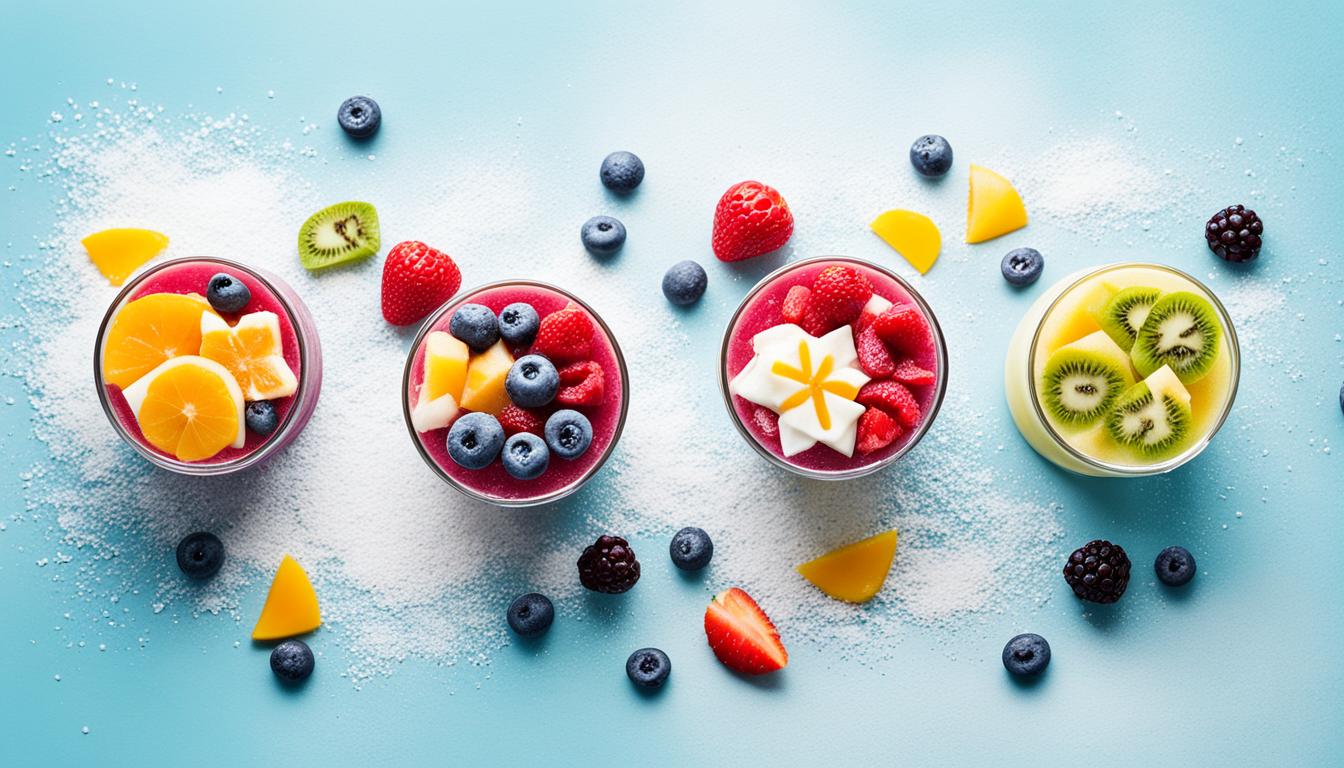
Imagine standing in the middle of an ice cream aisle, your heart racing at the sight of creamy scoops piled high, while the thought of managing diabetes looms over you like a heavy cloud. You’re not alone. Many people grapple with similar feelings when it comes to indulging in desserts. The good news is that you can enjoy the best ice cream for diabetics without compromising your health. Yes, there are diabetic-friendly ice cream options that let you savor every delightful scoop while keeping your blood sugar levels in check. As you explore low sugar ice cream for diabetics, you’ll learn that moderation and mindful choices make all the difference. Understanding what to look for in terms of nutritional content and serving sizes can turn an ordinary treat into a guilt-free pleasure.
Key Takeaways
- The best ice cream for diabetics generally contains less than 20 grams of carbohydrates per half-cup serving.
- Consider brands like Halo Top and Edy’s for their low sugar options and balanced nutrition.
- Always check nutrition labels to ensure your choices align with your dietary needs.
- Moderation is crucial; enjoy ice cream as an occasional treat rather than a regular indulgence.
- Home-made recipes using natural sweeteners like stevia are a great way to enjoy ice cream responsibly.
Understanding Diabetes and Ice Cream Choices
Over 37 million people live with diabetes in the United States. Managing blood sugar levels is essential for these individuals, influencing their dietary choices, including desserts like ice cream. Understanding carbohydrate intake becomes crucial when selecting ice cream that fits a diabetic diet.
When choosing diabetic diet ice cream, aim for options that comply with recommended guidelines: serving sizes should be under 225 calories, contain no more than 2 grams of saturated fat, and hold 30 grams of carbohydrates or less per serving. Sugar-free ice cream for diabetics is a fantastic way to enjoy a treat without compromising health. Look for ice creams sweetened with nonnutritive sweeteners such as erythritol, monk fruit, or stevia.
Consider added ingredients like nuts, which are high in protein, fiber, and healthy fats, making the ice cream even more beneficial. It’s wise to avoid flavors that contain extra sources of sugar, such as caramel and marshmallows, to maintain better blood glucose levels.
Here’s a quick overview of some popular ice cream options for diabetics:
| Brand/Flavor | Carbohydrates (per ½ cup) | Calories | Saturated Fat (g) |
|---|---|---|---|
| Edy’s Slow Churned Neopolitan | 14 | 100 | 2 |
| Breyers Creamy Vanilla | 17 | 150 | 3 |
| Blue Bunny Vanilla | 20 | 140 | 2.5 |
| Halo Top | 6 | 50 | 1 |

Sticking to suggested serving sizes is vital, with a ½ cup portion being ideal. Choices like Edy’s or Breyers provide delicious flavors while remaining mindful of carbohydrate content. With careful selection, you can successfully include delightful ice cream treats in your diabetic diet without significant impact on your blood sugar levels.
What Kind of Ice Cream Can Diabetics Eat?
Choosing the right ice cream is essential for managing diabetes effectively. Many options exist, but understanding the nutritional content can help you make informed decisions. You might wonder what kind of ice cream can diabetics eat while fulfilling your sweet cravings without compromising health. Prioritizing low glycemic index ice cream can significantly aid in controlling blood sugar levels.
Key Nutritional Considerations
When selecting ice cream, focus on key nutritional aspects:
- Calories: Aim for lower-calorie options, as this helps in weight and blood sugar management.
- Total Carbohydrates: Limit total carbohydrates to about 15-20 grams per serving for better glycemic control.
- Added Sugars: Look for diabetic-safe ice cream choices with no more than 12 grams of added sugars.
- Saturated Fats: The ideal cap should be set at about 2-3 grams of saturated fat per serving to promote heart health.
Impact of Carbohydrates on Blood Sugar
Carbohydrates can significantly impact blood sugar levels. Ice cream typically contains carbohydrates that can lead to glucose spikes if not managed properly. Consuming ice cream in moderation, particularly those rich in protein, can help slow the rise in blood sugar, making low glycemic index ice cream an excellent choice. Many brands now offer functional ice cream that substitutes unhealthy ingredients with healthier alternatives, allowing you to indulge without fear of compromising your health.

| Type of Ice Cream | Calories (per ½ cup) | Sugars (g) | Fat (g) | Carbs (g) |
|---|---|---|---|---|
| Traditional Ice Cream | 140 | 14 | 7 | 17 |
| Low-Fat Frozen Yogurt | 111 | 6 | 3 | 18 |
| Slow-Churned Ice Cream | 100 | 9 | 5 | 15 |
| Keto Ice Cream | 70 | 2 | 4 | 8 |
Remember to monitor your blood sugar levels after enjoying your favorite dessert. Using tools like HealthifyPRO CGM can provide insights into how different ice creams affect your glucose levels, helping you enjoy sweet treats safely.
Diabetic-Friendly Ice Cream Options
Finding the right ice cream can be challenging when you’re managing diabetes. Thankfully, there are many diabetic-friendly ice cream options available to satisfy your sweet tooth without compromising your health. It’s important to choose brands that prioritize low sugar content while still delivering on flavor.
Low Sugar Ice Cream Brands
Several ice cream brands cater specifically to those looking for low sugar ice cream for diabetics. Some popular choices include:
- Halo Top: Known for its low sugar content and high protein level, this brand uses erythritol, a natural sweetener.
- Edy’s Slow Churned: Their Neapolitan flavor contains just 14 grams of carbohydrates per half-cup serving.
- Breyers Smooth & Dreamy: With 17 grams of carbs in their Creamy Vanilla, this option stands out for being both delicious and diabetes-friendly.
- Blue Bunny Hi Lite: Their Vanilla and Chocolate varieties each have 20 grams of carbohydrates per half-cup, making them another decent choice.
Ice Creams with Natural Sweeteners
Choosing ice creams that incorporate natural sweeteners can make the difference when managing your blood sugar levels. These options often taste great while keeping carb counts low. Look for products labeled as “no sugar added,” but be mindful; they may still contain carbohydrates and naturally occurring sugars.
When selecting a low sugar ice cream for diabetics, consider these nutritional guidelines recommended by the American Diabetes Association: a maximum of 150 calories, 5 grams of total fat, 3 grams of saturated fat, 20 grams of carbs, and 100 milligrams of sodium per half-cup serving.
Enjoying ice cream recipes for diabetics is possible by using lower-carb varieties and monitoring your serving size. Keeping these tasty alternatives in mind can help integrate treats into your meal plans without sacrificing flavor or health.

| Brand | Flavor | Carbohydrates (g) per 1/2 cup |
|---|---|---|
| Halo Top | Various | Less than 10 |
| Edy’s Slow Churned | Neapolitan | 14 |
| Breyers Smooth & Dreamy | Creamy Vanilla | 17 |
| Blue Bunny Hi Lite | Vanilla & Chocolate | 20 |
Low Glycemic Index Ice Cream
Choosing low glycemic index ice cream can play a crucial role in managing diabetes. Foods that fall under this category are digested and absorbed more slowly, helping to maintain stable blood sugar levels. For those looking for diabetic-friendly ice cream options, selecting varieties with a low glycemic index is a smart choice.
Benefits of Low Glycemic Index Foods
Integrating low glycemic index foods into your diet offers various health advantages. These options help in:
- Maintaining steady blood sugar levels
- Reducing hunger and increasing satiety
- Improving overall energy levels
- Supporting better weight management
When it comes to ice cream, lower glycemic index varieties can satisfy your sweet tooth without causing significant spikes in blood sugar, making them ideal for those managing their diabetes.
Examples of Low Glycemic Ice Cream Choices
Here are some recommended low glycemic index ice cream options to consider:
| Ice Cream Brand | Serving Size | Carbs (g) | Sugar (g) | Calories |
|---|---|---|---|---|
| Halo Top (Keto series) | 2/3 cup | 16 | 1 | 130 |
| Light No-Sugar Vanilla | ½ cup | 15 | 4 | 105 |
| So Delicious Dairy Free | ½ cup | Varies | Varies | Varies |
These options provide a balance of flavor and nutritional benefits while helping you manage your carbohydrate intake. Making mindful choices like these can enhance your overall wellness.

Best Ice Cream for Diabetes: Top Brands
Finding the best ice cream for diabetes can be a challenge, but numerous brands have created options that cater to your needs while still satisfying your sweet tooth. Below are highlights of such brands that stand out in the realm of diabetic diet ice cream.
Halo Top
Halo Top is a popular choice for those managing diabetes. Its ice cream is formulated to be low in sugar and high in protein, making it a fitting alternative for blood sugar management. With erythritol as a sweetener, it provides sweetness without unnecessary calories, allowing you to enjoy a delicious treat without compromising your health. Flavors range from classic vanilla to creative combinations that are sure to please any palate.
Edy’s Slow Churned
Edy’s Slow Churned Ice Cream is another fantastic option in the realm of diabetic-friendly desserts. It boasts a carbohydrate count of 20 grams or less per half-cup serving, with specific flavors like Neopolitan containing as little as 14 grams. This brand offers a good variety of flavors while maintaining reasonable sugar levels, making it a practical choice for your diabetic diet ice cream collection.

Homemade Ice Cream Recipes for Diabetics
Making your own ice cream can be an enjoyable and healthier way to satisfy your cravings. You have complete control over the ingredients, allowing you to create delicious ice cream recipes for diabetics that adhere to your dietary needs. Below, you will find simple base recipes alongside enticing low-sugar add-ins and flavorings that will elevate your homemade diabetic diet ice cream to delightful new heights.
Simple Base Recipes
Creating a creamy and flavorful base for your ice cream is easier than you think. Here’s a quick vanilla ice cream recipe to get you started:
- 2 cups heavy cream
- 1 cup unsweetened almond milk
- 3/4 cup allulose sweetener
- 1 tablespoon vanilla extract
- 1 teaspoon xanthan gum
Blend the ingredients until smooth, then refrigerate for about 30 minutes before churning in an ice cream maker. This recipe yields approximately 3½ cups of ice cream, each serving containing roughly 6 grams of net carbs. For a fun twist, consider adding fruit or nuts before freezing!
Low-Sugar Add-Ins and Flavorings
Adding low-sugar flavorings can enhance your homemade ice cream experience. Consider these options:
- Fresh Fruits: Strawberries, bananas, and blueberries can be blended into your ice cream for natural sweetness.
- Cocoa Powder: Add unsweetened cocoa powder for a decadent chocolate flavor.
- Extracts: Almond or mint extracts can provide a refreshing touch.
- Mix-ins: Nuts, coconut flakes, or sugar-free granola add texture and flavor.
For example, you might create a strawberry-banana nice cream by blending ripe bananas and frozen strawberries until smooth, resulting in a refreshing treat perfect for hot days.

Experiment with these innovative ideas to craft the ultimate diabetic diet ice cream, keeping health and flavor at the forefront. By following the simple base recipes and incorporating low-sugar add-ins, you will find satisfying ways to indulge while staying within the bounds of your dietary requirements.
Additional Factors to Consider
When selecting your ice cream, pay close attention to the presence of saturated fat. People with diabetes should be mindful of their saturated fat intake due to the associated risk factors for heart disease. This consideration becomes crucial when analyzing various ice cream products.
Saturated Fat and Its Implications
Often, traditional ice creams contain high levels of saturated fat, which can lead to health complications over time. For healthier options, look for sugar-free ice cream for diabetics that specifically market lower saturated fat. Brands like Halo Top and Arctic Zero offer diabetic-safe ice cream choices that cater to your dietary needs without compromising flavor.
Reading Nutrition Labels Effectively
Understanding how to read nutrition labels can empower you to make informed decisions about your ice cream selections. Here are a few key factors to focus on:
- Sugar Content: Opt for ice creams with lower sugar levels, particularly those marked as sugar-free.
- Saturated Fat: Choose products with minimal saturated fat to support heart health.
- Serving Size: Consider the serving size to prevent overindulgence, especially with richer flavors.
- Ingredient List: Be wary of overly processed ingredients; select options with natural ingredients whenever possible.

By putting in the effort to understand nutrition labels and selecting sugar-free ice cream for diabetics, you can make more informed choices that align with your health objectives. This approach not only helps in managing your diabetes but also supports overall well-being.
How to Incorporate Ice Cream into Your Diet
Finding ways to enjoy ice cream while managing your health can be a delightful journey. Understanding how to incorporate ice cream into your diet helps create a balanced approach to enjoying this tasty treat. Focusing on portion control and making smarter choices allows you to savor ice cream without compromising your dietary goals.
Serving Size Recommendations
A general guideline for serving ice cream is about a half-cup. This size helps manage intake and keeps blood sugar fluctuations in check. Opting for lower-sugar options can mitigate the likelihood of rapid spikes in blood sugar levels.
- Rebel Coffee Chip Ice Cream: 210 calories, 16g carbs, 0g sugars per serving.
- Nubocha Chocolate Arriba Gelato: 100 calories, 31g carbs, 0 sugars per serving.
- Enlightened Keto P.B. Cookie & Brownie Dough: 230 calories, 20g carbs,
- Nick’s Swedish-Style Light Ice Cream Birthdäg Cake: 80 calories, 21g carbs, 0g sugars per serving.
- So Delicious Dairy Free No Sugar Added Mint Chip Coconutmilk: 160 calories, 25g carbs, 2g sugars per serving.
Balancing Ice Cream with Other Nutritional Needs
Including ice cream in your diet requires a focus on balance. Consider complementing your treat with nutrient-dense, fiber-rich foods. Ingredients such as chia seeds or flaxseeds can enhance the nutritional value of your ice cream choices. For instance, avocado chocolate ice cream brings healthy fats and fiber into the mix, eliminating added sugars. Likewise, berry yogurt popsicles provide protein and antioxidants with minimal sugar.

This harmonious approach not only satisfies your cravings but also stabilizes blood sugar levels. By selecting options made with natural sweeteners like stevia or monk fruit, you contribute towards maintaining your overall health without sacrificing taste.
| Ice Cream Type | Calories | Total Fat (g) | Total Carbs (g) | Fiber (g) | Sugars (g) | Protein (g) | Price (per pint) |
|---|---|---|---|---|---|---|---|
| Rebel Coffee Chip | 210 | 21 | 16 | 4 | 0 | 3 | $5.99 |
| Nubocha Chocolate Arriba Gelato | 100 | 8 | 31 | 1 | 0 | 2 | $12 |
| Enlightened Keto P.B. Cookie & Brownie Dough | 230 | 20 | 20 | 5 | 6 | $9 | |
| Nick’s Swedish-Style Light Ice Cream Birthdäg Cake | 80 | 5 | 21 | 8 | 0 | 3 | $9.99 |
| So Delicious Dairy Free No Sugar Added Mint Chip | 160 | 11 | 25 | 11 | 2 | 2 | $6.39 |
Creative Alternatives to Traditional Ice Cream
When looking for delightful treats that are friendly to your blood sugar levels, consider the various creative options available. Traditional ice cream can sometimes be loaded with sugar and carbs, making it challenging for you to enjoy without worry. Exploring alternatives can lead you to discover diabetes-friendly ice cream options that still satisfy your cravings.
Frozen Yogurt vs. Ice Cream
Frozen yogurt often emerges as a favorable substitute for standard ice cream. Generally lower in fat than traditional ice cream, it can provide a creamy texture while keeping the calorie count reasonable. However, not all frozen yogurt is created equal. It’s essential to choose varieties that contain less added sugar. With taste ratings for frozen yogurt ranging from 4/10 to 9/10, you can find enjoyable and satisfactory options that meet your health goals.
Fruit-Based Sorbets and Popsicles
Fruit-based sorbets and popsicles stand out as refreshing choices for cooling down on warm days. These alternatives typically consist of pureed fruits and little to no added sugar, making them suitable diabetes-friendly ice cream options. When selecting your treats, keep an eye out for those made with whole fruit for the best nutritional benefits. You can expect tasty options with ratings often exceeding 8/10, providing that sweet satisfaction without the negative impacts on your blood sugar.

| Type | Sugar Content | Taste Rating (out of 10) | Texture Rating (out of 10) |
|---|---|---|---|
| Frozen Yogurt | Varies (typically lower) | 4-9 | 5-10 |
| Fruit-Based Sorbets | Low to No Sugar | 8-9 | 7-9 |
| Popsicles | Generally Low | 8-9 | 6-8 |
By choosing frozen yogurt, fruit-based sorbets, and popsicles, you can still enjoy a sweet treat while keeping your nutritional goals in check. With a wide range of flavors available, the creative alternatives to traditional ice cream can add excitement to your dessert choices without compromising your health.
Tips for Enjoying Ice Cream Responsibly
For those navigating a diabetic diet, finding ways to enjoy ice cream without compromising health is crucial. You can savor this treat while minimizing blood sugar spikes by effectively planning your consumption around meals. This planning will allow you to enjoy your favorite ice creams as part of a balanced approach, ensuring that it aligns with your nutritional goals.
Planning Treats Around Meals
Strategically timing ice cream indulgences can enhance your dining experience while aiding in blood sugar management. Consider these helpful tips:
- Pair ice cream with a meal to slow down sugar absorption.
- Choose dessert after a protein-rich meal to further stabilize blood sugar levels.
- Balance sweets with a serving of fiber or healthy fats to minimize glucose spikes.
Understanding Portion Control
Understanding portion control is essential when integrating diabetic diet ice cream into your diet. Smaller servings can help you enjoy the flavors you love while keeping blood sugar in check. Here are effective strategies:
- Limit servings to half a cup to maintain sensible intake.
- Use measuring cups to avoid guessing and ensure accuracy.
- Keep a journal to track intakes and their effects on your blood sugar.

| Ice Cream Type | Recommended Serving Size | Notes |
|---|---|---|
| Low Sugar Ice Cream | 1/2 cup | Opt for brands with artificial sweeteners. |
| Frozen Yogurt | 1/2 cup | Lower in sugar; usually contains probiotics. |
| Fruit Sorbet | 1/2 cup | Check sugar content; fruit sweetness varies. |
By understanding portion control, you can enjoy treats while minimizing health risks. Maintain a balanced diet, and ice cream can fit into your lifestyle as an occasional pleasure, allowing you to enjoy your favorites without missing out.
Conclusion
Choosing ice cream as part of a diabetes-friendly lifestyle doesn’t have to be daunting. You can enjoy the best ice cream for diabetes by focusing on brands that prioritize lower sugar content and maintain transparency in their ingredients. Exploring diabetic-friendly ice cream options, such as those sweetened with natural alternatives or lower-carb varieties, can help satisfy your cravings while managing blood sugar effectively.
Understand that moderation is key, and maintaining portion control is essential when you indulge in desserts like ice cream. By monitoring your blood sugar levels, you can gauge the impact of different flavors and types. Also, experimenting with homemade recipes allows you to tailor your treats to your dietary needs, making it easier to enjoy the pleasures of ice cream without compromising your health.
Ultimately, living with diabetes means making informed choices every day. By incorporating the best ice cream for diabetes into your diet responsibly, you can experience the joy of sweet treats while prioritizing your wellbeing, allowing you to savor life’s simple pleasures.
FAQ
What kind of ice cream can diabetics eat?
Are there low sugar ice cream options for diabetics?
How can I read nutrition labels to choose diabetic-friendly ice cream?
What are the best ice cream brands for diabetes?
Can diabetics make homemade ice cream?
What are some creative ice cream alternatives suitable for diabetics?
How should I plan my ice cream consumption as a diabetic?
What low glycemic index ice cream options are there?
How can I enjoy ice cream while managing my diabetic diet?
Mia is the connector for the “Ice Cream Hater” team, responsible for spreading the word about our brand and building relationships with our audience and partners. With a background in marketing and a passion for community engagement, Mia manages our outreach efforts, coordinates marketing campaigns, and develops strategies to expand our reach. She is passionate about bringing the joy of ice cream to as many people as possible and is always looking for new ways to share our content with the world.
-

 Vetted3 months ago
Vetted3 months agoThe 11 Best Ice Cream Machines of 2024 – Which One Is Right for You
-

 Ice Cream & Health3 months ago
Ice Cream & Health3 months agoIce Cream Pricing Guide – What to Expect in the US
-

 Vetted3 months ago
Vetted3 months agoBlue Bell Ice Cream: Is It Worth the Hype? An Honest Review
-

 Ice Cream Recipes3 months ago
Ice Cream Recipes3 months agoNeapolitan Ice Cream: The Best of Three Worlds in One Scoop
-

 Vetted3 months ago
Vetted3 months ago15 Best Ice Cream Machines of 2024 – Your Guide to Homemade Frozen Delights
-

 Vetted3 months ago
Vetted3 months ago15 Best Commercial Soft Serve Ice Cream Machines of 2024 – Creamy Delights for Your Business
-

 Vetted3 months ago
Vetted3 months ago15 Best Ice Cream Machines for Delicious Homemade Treats in 2024
-

 Vetted3 months ago
Vetted3 months ago15 Best Compressor Ice Cream Machines of 2024 for Homemade Frozen Treats





























